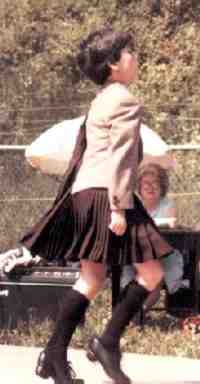
Irish Step Dancing Lessons

Figure 1.--Judges carefully watch this dancer's foot work. The normal boy's costume for Irish dancing is a short jacket, white shirt, tie, shoulder
sash, kilt, and kneesocks. The kneesocks usually match either the jacket or the kilt. Some American dancing schools let the boys wear long black pants, but this is not common in Ireland.
|
Organizations
Several organizations exist to qualify Irish step dancing teachers. They have to passed the relevant exams and are then recognised by their own organisation as capable of teaching. Several such oganisations operate around the world.
The Commissiion
The largest is An Coimisiun Le Rince Gaelacha (the Commission) with headquarters in Dublin. Their teachers are based around the world, but in North America, the Irish Dance Teacher's Association of North America (IDTANA) are in charge of the various American and Canadian regions. Similarly in Australia, the Australian Irish Dance Association (AIDA) has their own local organisations.
The Cogaul
The next largest is An Comhdhail (the Cogaul), based mainly in Dublin but has lots of branches in London, Scotland and across Ireland. They have their own exams and qualified teachers, and their own annual championships.
Other organizatiins
Other organisations include the Cunnan Rince Naisunta (CRN) and the Festival Dance Teacher's Association (FDTA.)
Choosing a Teacher
Choosing the apopropriate Irish dance teacher is avery imortant matter. There are advantages in choosing a teacher who belongs to one of the larger organisations, especially if the dancer wants to comoete. Such teachers will probably incourage more competition and improve quicker as a dancer. On the other hand, a dancer or his parents may prefer a friendlier, low-key approach, where it's more about fun and socialising, than winning medals. As a starting point though, it's wise to find a school near to where you live, and get a first taste of Irish dancing.
Formal Lessons
Formal lessons of an Irish dance school generally follows an academic calendar, beginning in September and ending in May/June. Teachers, however may accept new
students at any time during the year. You can expect your beginner's lesson to run
approximately one hour, one afternoon or evening each week. Additionally, the
teacher may call for extra lessons, especially before an important performance or
competition. These lessons may or may not require additional lesson fees depending
on the circumstances. Also, private or semi-private (two or three dancers) lessons
can be arranged with the teacher throughout the year at an agreed fee schedule.
Parents
Parents shouldn't expect to remain in the same room while lessons are in progress. Like an academic setting, the teacher needs to be in control of the class and have the full attention of the students. However, a teacher may open certain lessons for parents to observe and question. These nights may be beneficial to the parent keeping abreast of the child's development thus being able to more
closely monitor his/her practice at home.
Teaching Sets
Teaching methods for adults learing sets are quite different. One teacher explains when teaching a new set, he typically gives a brief verbal overview of the figure, walk
through the movements, and then dance it to music. As a teaching aid the dances are usually
called, but the calls are only simple, brief cues to serve as reminders. Mos teachers give special attention to regional footwork and styling, and strive for more of a club atmosphere. Some classes tend to be more thorough on basic instruction.
Some teachers when learning a dance, like to have people dance with different partners. Dancing improves the more we dance with a variety of partners. Other teachers don't like to split up couples who have come to dance together, so they may move people around only
when teaching a dance. Once a dance is learned, they then dance it again straight through with the partner of choice.
Christopher Wagner

Navigate the Historic Boys' Clothing Web Site:
[Introduction]
[Activities]
[Bibliographies]
[Biographies]
[Chronologies]
[Contributions]
[Countries]
[Frequently Asked Questions]
[Style Index]
[Boys' Clothing Home]
Navigate the Historic Boys' Clothing Web chronological pages:
[The 1880s]
[The 1890s]
[The 1900s]
[The 1910s]
[The 1920s]
[The 1930s]
[The 1940s]
[The 1950s]
[The 1960s]
[The 1970s]
[The 1980s]
[The 1990s]
Navigate the Historic Boys' Clothing Web dance pages:
[Main dance page]
[Ballet]
[Irish step]
[Highland]
[Ballroom]
[Native American]
[Tap]
Navigate the Boys' Historical Clothing kilt pages:
[Main kilt page]
[Kilt suits]
[Scottish kilts]
[Scottish boys clothing]
[Scottish school uniform]
[Highland dance]
[Irish kilts]
[Irish boys clothing]
[Irish step dancing]
[Greek kilts]
Created: May 13, 2000
Last updated: September 21, 2000



